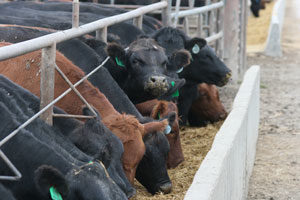Food safety organizations argue the prevalence of antibiotic drugs in food-producing animals leads to growing antimicrobial resistance in those same drugs when used to fight bacteria in human sickness.
The FDA’s new guidelines include:
• Newly released “Judicious Use Guidelines” (labeled Guidance No. 209) that limit antimicrobial drugs only for the use of assuring animal health, and to include veterinary oversight and consultation.
• A drafted “Guidance for Industry” (Guidance No. 213) for drug companies to voluntarily remove from their labels any antibiotic uses for feed production uses, and changing marketing status to include a vet’s oversight. The draft is open for public comment.
• A drafted “Veterinary Feed Directive” regulation, also open for public comment, outlining how vets can authorize certain animal drugs in feed.
Once Guidance 213 is finalized, the FDA says the guidelines will be adopted voluntarily by the industry. After a three-year period, “FDA intends to evaluate the rate of voluntary adoption” and will then “consider further action as warranted…”
Dr. Bill Flynn, deputy director for science policy at the FDA’s Center for Veterinary Medicine, said the goal for voluntary compliance would be difficult to quantify, but that reductions would be expected.
“We feel confident that it’s going to have an affect in terms of not only reducing use in some manner of time,” Flynn said in a conference call to reporters, “it’s a matter of also making sure that we’re using the drugs … in a smart a way as possible so as to minimize the impact of that use on resistance development.”
The FDA rules specifically target antibiotic drugs considered medically important in its 2003 guidance documents, also known as Guideline 152. Among those classified as the most critical drugs to be limited third-generation cephalosporins, fluoroquinolones and macrolides. Those drugs will not be regulated for uses in treatment or prevention, but only in growth promotion.
Dr. Dee Griffin, faculty member at the University of Nebraska’s Great Plains Veterinary Education Center, said the scientific tug-of-war over antibiotics has grown more political in recent years.
He said data from the National Antimicrobial Resistance Monitoring System (NARMS), done jointly by the FDA, USDA and Centers for Disease Control and Prevention, has not suggested a link to human resistance. “But there’s a tremendous amount of public pressure internationally about antibiotic use control,” he said.
“Among that class are some of the antibiotics that are currently the top treatment antibiotics, and most potent or useful antibiotics we have for treatment, not for prevention or feed, in cattle.”
“A number of those have labels for feed efficiency or growth promotion, and they want those pulled.”
In a conference call with reporters announcing the decision, the FDA defended using voluntary compliance, noting “a sea change” from within the animal industry that understands “the need to move forward on this issue.”
But Griffin said the guidance documents should set off an alarm for the industry, given how the FDA’s previous antibiotic bans on cephalosporin detailed the agency’s use of “precautionary principle.” That term allows FDA to consider more than just scientific evidence science but also what FDA called “other suitable information” to weigh risks of the drugs’ use.
Griffin said that principle can be “really disturbing” to animal science experts who try to keep science separate from the politics.
The National Cattlemen's Beef Association in a statement applauding the FDA's move not to completely remove therapeutic uses of antibiotics, but reaffirmed the need for "the necessary science in its recommendations."
"(W)e remain concerned with regulatory actions that are not based on peer-reviewed science or that set the precedent to take animal care and health decisions out of the hands of veterinarians....
"Prudent and responsible evaluation of this issue must consider animal, human and industrial use of antibiotics. While we appreciate the agency working with industry on the implementation of Guidance 209, we remain committed that a strong science foundation is critical before moving forward with this guidance."
The NCBA issued its own guide for judicious use of antimicrobials in 2001, recommending producers follow all FDA rules on extra-label uses, and that antibiotics “should not be used if the principle intent is to improve performance.”
“I don’t think the use of antibiotics in feed is a big deal for us,” Griffin added. “They’re not going to touch any of the ionophores. … If you took all the rest of them, I don’t think it would have a tremendous impact on the production of beef.”
Producer groups also expressed concern about the guidelines requiring antibiotics be administered only by a vet.
“We’re not putting out enough food animal vets who are experts out of our vets schools, don’t have enough manpower to oversee that kind of a system,” said Dr. John Maas, a veterinarian with the University of California, Davis.
“The European nations, where there’s quite a bit of subsidies, they do have manpower to do it. But for what we have in the U.S. we don’t have the manpower to oversee that stuff if they went that way.”
FDA says it hopes the public comment period will gather feedback on how to mitigate producers’ concerns on the lack of veterinarian access. ![]()
PHOTO
New FDA guidelines will implement voluntary compliance with regulations against antibiotic use in feed, but ionophore classes will still be allowed. Staff photo.







